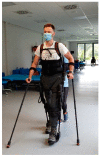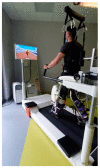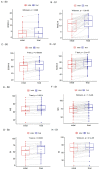Impact of Robotic-Assisted Gait Training in Subacute Spinal Cord Injury Patients on Outcome Measure
- PMID: 37296818
- PMCID: PMC10252491
- DOI: 10.3390/diagnostics13111966
Impact of Robotic-Assisted Gait Training in Subacute Spinal Cord Injury Patients on Outcome Measure
Abstract
The improvement of walking ability is a primary goal for spinal cord injury (SCI) patients. Robotic-assisted gait training (RAGT) is an innovative method for its improvement. This study evaluates the influence of RAGT vs. dynamic parapodium training (DPT) in improving gait motor functions in SCI patients. In this single-centre, single-blinded study, we enrolled 105 (39 and 64 with complete and incomplete SCI, respectively) patients. The investigated subjects received gait training with RAGT (experimental S1-group) and DPT (control S0-group), with six training sessions per week over seven weeks. The American Spinal Cord Injury Association Impairment Scale Motor Score (MS), Spinal Cord Independence Measure, version-III (SCIM-III), Walking Index for Spinal Cord Injury, version-II (WISCI-II), and Barthel Index (BI) were assessed in each patient before and after sessions. Patients with incomplete SCI assigned to the S1 rehabilitation group achieved more significant improvement in MS [2.58 (SE 1.21, p < 0.05)] and WISCI-II [3.07 (SE 1.02, p < 0.01])] scores in comparison with patients assigned to the S0 group. Despite the described improvement in the MS motor score, no progression between grades of AIS (A to B to C to D) was observed. A nonsignificant improvement between the groups for SCIM-III and BI was found. RAGT significantly improved gait functional parameters in SCI patients in comparison with conventional gait training with DPT. RAGT is a valid treatment option in SCI patients in the subacute phase. DPT should not be recommended for patients with incomplete SCI (AIS-C); in those patients, RAGT rehabilitation programs should be taken into consideration.
Keywords: SCI; Walking Index; disability scales; rehabilitation; robotic therapy.
Conflict of interest statement
The authors declare no conflict of interest.
Figures





Similar articles
-
Impact of Robotic-Assisted Gait Therapy on Depression and Anxiety Symptoms in Patients with Subacute Spinal Cord Injuries (SCIs)-A Prospective Clinical Study.J Clin Med. 2023 Nov 17;12(22):7153. doi: 10.3390/jcm12227153. J Clin Med. 2023. PMID: 38002765 Free PMC article.
-
Surface electromyography vs clinical outcome measures after robot-assisted gait training in patients with spinal cord injury after post-acute phase of rehabilitation.Ann Agric Environ Med. 2024 Dec 22;31(4):599-608. doi: 10.26444/aaem/189609. Epub 2024 Jul 8. Ann Agric Environ Med. 2024. PMID: 39743720
-
Effects of robot-assisted gait training on lower extremity strength, functional independence, and walking function in men with incomplete traumatic spinal cord injury.Turk J Phys Med Rehabil. 2020 Mar 3;66(1):54-59. doi: 10.5606/tftrd.2020.3316. eCollection 2020 Mar. Turk J Phys Med Rehabil. 2020. PMID: 32318675 Free PMC article.
-
The effects of robot assisted gait training on temporal-spatial characteristics of people with spinal cord injuries: A systematic review.J Spinal Cord Med. 2018 Sep;41(5):529-543. doi: 10.1080/10790268.2018.1426236. Epub 2018 Feb 5. J Spinal Cord Med. 2018. PMID: 29400988 Free PMC article.
-
Effects of robot-assisted gait training on cardiopulmonary function and lower extremity strength in individuals with spinal cord injury: A systematic review and meta-analysis.J Spinal Cord Med. 2024 Jan;47(1):6-14. doi: 10.1080/10790268.2023.2188392. Epub 2023 Mar 27. J Spinal Cord Med. 2024. PMID: 36972206 Free PMC article.
Cited by
-
Effects of a Gait Training Program on Spinal Cord Injury Patients: A Single-Group Prospective Cohort Study.J Clin Med. 2023 Nov 21;12(23):7208. doi: 10.3390/jcm12237208. J Clin Med. 2023. PMID: 38068259 Free PMC article.
-
Clinical Utility of Robot-Assisted Gait Training in Patients with Spinal Cord Injury Caused by Electrical Burns: A Case Report.J Clin Med. 2023 Nov 21;12(23):7220. doi: 10.3390/jcm12237220. J Clin Med. 2023. PMID: 38068271 Free PMC article.
-
The use of exoskeleton robotic training on lower extremity function in spinal cord injuries: A systematic review.J Orthop. 2024 Oct 30;65:1-7. doi: 10.1016/j.jor.2024.10.036. eCollection 2025 Jul. J Orthop. 2024. PMID: 39713557 Review.
-
Impact of Robotic-Assisted Gait Therapy on Depression and Anxiety Symptoms in Patients with Subacute Spinal Cord Injuries (SCIs)-A Prospective Clinical Study.J Clin Med. 2023 Nov 17;12(22):7153. doi: 10.3390/jcm12227153. J Clin Med. 2023. PMID: 38002765 Free PMC article.
-
Improving Outcomes in People with Spinal Cord Injury: Encouraging Results from a Multidisciplinary Advanced Rehabilitation Pathway.Brain Sci. 2024 Jan 28;14(2):140. doi: 10.3390/brainsci14020140. Brain Sci. 2024. PMID: 38391715 Free PMC article.
References
-
- Haas B., Playford E.D., Ahmad A.Q., Yildiran T., Gibbon A.J., Freeman J.A. Rehabilitation goals of people with spinal cord injuries can be classified against the International Classification of Functioning, Disability and Health Core Set for spinal cord injuries. Spinal Cord. 2016;54:324–328. doi: 10.1038/sc.2015.155. - DOI - PubMed
Grants and funding
LinkOut - more resources
Full Text Sources

